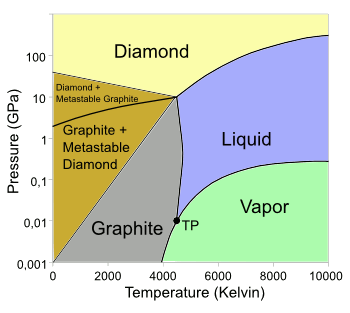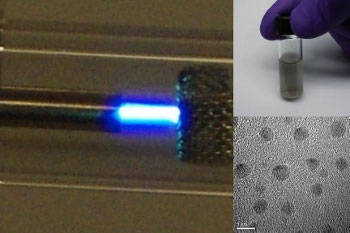Making Diamonds
December 16, 2013
Contrary to advertising claims,
diamonds are not forever. Diamond will burn, just like its
chemical cousin,
charcoal, if
combustion is initiated. The combustion
product is
carbon dioxide.
Thermodynamics confirms this
observation, since the
free energy of the combustion
reaction at
standard temperature and pressure (298.15
K and 1
atmosphere) is negative;[1] viz.,
C(Diamond) + O2(gas) -> CO2(gas)
ΔGf(Diamond) = 0.693 kcal/mole
ΔGf(Oxygen) = 0 kcal/mole
ΔGf(Carbon Dioxide) = -94.258 kcal/mole
ΔG(Reaction) = -94.951 kcal/mole
Although the reaction is highly favored at
room temperature, this combustion reaction has an
activation energy that must be overcome before it happens. As a consequence, diamond
will only ignite at a
temperature of 850-1,000°C in air, or 720-800°C in pure oxygen.
The combustion of diamond to form carbon dioxide was
experimentally confirmed by
Antoine Lavoisier in 1772. Lavoisier concentrated the
Sun's rays with a
lens to heat a diamond in an oxygen atmosphere to produce carbon dioxide. Later, the
chemist,
Smithson Tennant, showed that the combustion of
graphite produced the same result, confirming that diamond and graphite are
allotropic forms of
carbon.

The carbon phase diagram.
The triple point (TP) is around 4600 K and 10.8 MPa.
(Wikimedia Commons image, from data in ref. 2, modified using Inkscape.)[2)]
As the carbon phase diagram shows, the diamond phase of carbon exists only at high temperatures and high pressures. Such conditions occur at depths about a hundred
miles within
Earth's mantle, and natural diamonds have grown there over the course of
billions of years. They're available at Earth's surface only though transport of
magma in
volcanic eruptions, and they occur in the
igneous rocks,
kimberlite and
lamproite.
The
French chemist,
Henri Moissan, who won the 1906
Nobel Prize in Chemistry for his
research on
fluorine, thought he had discovered a simple process to mimic the temperature and pressure conditions necessary for diamond formation. Carbon dissolves in
iron, and that's how we get
steel.
Moissan saturated iron with carbon at about 3500°
C, and then
quenched the
metal in cold
water. He hoped that the
compressive forces of
solidification would transform the carbon into diamond, and he did find diamond-like
crystals in the product.
Sir Charles Parsons, an
Anglo-Irish engineer and
inventor of the
steam turbine, tried to
reproduce Moissan's results, but he wasn't able to make diamonds. It's possible that Moissan had actually produced crystals of
magnetite (Fe
3O
4).[3]
High pressure
technology advanced considerably in the
20th century, mostly though the efforts of
American physicist,
Percy Bridgman (1882-1961). Bridgeman won the 1946
Nobel Prize in Physics for his high pressure research. It had finally become possible to do a brute-force
synthesis of diamond through application of the proper temperatures and pressures.
Tracy Hall, a
physical chemist working at the
General Electric Research Laboratory in
Schenectady, New York, advanced Moissan's carbon-in-iron process by doing it in a high temperature
press. Hall's
apparatus, which first produced diamonds on December 16, 1954, could reach 2000°C and 10
GPa.[3] Small (0.15
millimeter) diamonds, useful for
industrial purposes, were produced not only from graphite mixed with iron, but mixed also with
nickel and from
iron sulfide.[4-5] Hall's reward for changing the world was apparently a $10
US savings bond (purchase value, $5.00).[6]

The crystal structure of diamond is cubic, with each carbon atom joined to others by a 154 picometer bond.
(Wikimedia Commons image, modified using Inkscape.)
This high temperature-high pressure condition is required when you're changing graphite to diamond, but
materials scientists wondered whether the diamond crystal structure might be built atom-by-atom from the
decomposition of
organic chemicals.
The simplest of these is
methane (CH
4), which is mixed in small quantities with
hydrogen gas and excited into a
plasma at low pressures. The gas atoms have a separate identity in the plasma, and some of the carbon atoms will form diamond on a
substrate. The purpose of the excess hydrogen is to strip away carbon not bonded into diamond.
This
chemical vapor deposition (CVD) process produces
polycrystalline diamond at a very low growth rate, since the reaction is limited by the available quantity of carbon in the plasma. However,
thin films of diamond are useful for a variety of applications, from
scratch-resistant eyeglasses to
low wear mechanical components.
One company has developed a method to make larger, single crystal diamond by a similar process.
Since diamond has unique material properties, such as high
thermal conductivity and extreme
hardness, there's still ongoing research into methods of diamond production.
Chemical engineers at
Case Western Reserve University (Cleveland, Ohio) have teamed with
physicists at
Michigan Technological University (Houghton, Michigan) to develop a process for making
nanoscale diamonds (nanodiamonds). Their CVD process is unlike other such processes, since it produces a nanodiamond
powder in a gas-phase reaction without a substrate.[7-8]
These nanodiamonds of 2-5
nanometer size are produced in a reaction of
ethanol (CH
3CH
2OH) and hydrogen at
atmospheric pressure and a (non-plasma) temperature of less than a hundred degrees
Celsius. Assistance in plasma creation came from an
argon carrier gas.[8] The nanodiamonds are true diamonds with
diamond cubic,
n-diamond and
lonsdaleite crystal structure.[7] Interestingly, lonsdaleite, an
hexagonal form of diamond, is rare on Earth but found in
meteorites, so the
cosmos has been making nanodiamonds for
eons.[7-8]

Nanodiamond synthesis at Case Western Reserve University.
Bright blue plasma is shown at the left, producing nanodiamonds at bottom.
(Case Western Reserve University images.[7]
Says
Mohan Sankaran, an
associate professor of
chemical engineering at Case Western Reserve and the leader of the project,
"This is not a complex process: ethanol vapor at room temperature and pressure is converted to diamond... We flow the gas through a plasma, add hydrogen and out come diamond nanoparticles. We can put this together and make them in almost any lab."[8]
One helpful factor was the
surface energy of diamond. This makes the nanodiamonds more stable than graphite, since nanoparticles have a high
ratio of surface area to volume. This ensured that most
nucleated nanoparticles would be diamond, and the hydrogen removed any non-diamond particles.[8]
References:
- Free energy data from L. B. Pankratz, "Thermodynamic Properties of Elements and Oxides," U. S. Bureau of Mines Bulletin 672, U. S. Government Printing Office (1982).
- J.M. Zazula, "On Graphite Transformations at High Temperature and Pressure Induced by Absorption of the LHC Beam," LHC Project Note 78, CERN, January 18, 1997 (PDF File).
- Artificial Diamonds, Human Touch of Chemistry Web Site.
- Howard Tracy Hall, "Diamond synthesis," U.S. Patent No. 2,947,608, August 2, 1960 (via Google Patents).
- H. P. Bovenkerk, F. P. Bundy, H. T. Hall, H. M. Strong and R. H. Wentorf, Jr., "Preparation of Diamond," Nature, vol. 184 (October 10, 1959), pp. 1094-1098 (PDF reprint at Tracy Hall Web Site).
- Thomas H. Maugh II, "General Electric chemist invented process for making diamonds in lab - H. Tracy Hall, 1919 - 2008," Los Angeles Times, July 31, 2008.
- Ajay Kumar, Pin Ann Lin, Albert Xue, Boyi Hao, Yoke Khin Yap and R. Mohan Sankaran, "Formation of nanodiamonds at near-ambient conditions via microplasma dissociation of ethanol vapour," Nature Communications, vol. 4, article no. 2618 (October 21, 2013), doi:10.1038/ncomms3618.
- Researchers develop way to inexpensively create nanodiamonds in lab setting, Case Western Reserve University Daily, October 28, 2013.
Permanent Link to this article
Linked Keywords: Diamond; allotropes of carbon; charcoal; combustion; product; carbon dioxide; thermodynamics; observation; Gibbs free energy; chemical reaction; standard conditions for temperature and pressure; standard temperature and pressure; STP; kelvin; K; bar; atmosphere; kilocalorie per mole; kcal/mole; oxygen; carbon dioxide; room temperature; activation energy; material properties of diamond; temperature; experiment; Antoine Lavoisier; Sun; lens; chemist; Smithson Tennant; graphite; allotropic form; carbon; phase diagram; triple point; Wikimedia Commons; Inkscape; mile; Earth's mantle; geologic time scale; billions of years; magma; volcanic eruption; igneous rock; kimberlite; lamproite; France; French; chemist; Henri Moissan; Nobel Prize in Chemistry; research; fluorine; iron; steel; Celsius; C; quenching; quench; metal; water; compression; compressive forces; freezing; solidification; crystal; Sir Charles Parsons; Anglo-Irish; engineer; inventor; steam turbine; reproducibility; magnetite; technology; 20th century; United States; American; physicist; Percy Bridgman (1882-1961); Nobel Prize in Physics; synthesis; Tracy Hall; physical chemist; General Electric Research Laboratory; Schenectady, New York; press; apparatus; pascal; GPa; millimeter; industrial-grade diamond; nickel; pyrite; iron sulfide; US savings bond; diamond cubic; chemical bond; materials science; materials scientist; chemical decomposition; organic compound; organic chemical; methane; hydrogen gas; plasma; substrate; chemical vapor deposition; CVD; polycrystalline; thin film; scratch resistance; scratch-resistant; eyeglasses; tribology; low wear; mechanical component; Apollo Diamond; thermal conductivity; hardness; chemical engineer; Case Western Reserve University (Cleveland, Ohio); physicist; Michigan Technological University (Houghton, Michigan); nanoscopic scale; nanoscale; powder; nanometer; ethanol; atmospheric pressure; Celsius; argon; diamond cubic; n-diamond; lonsdaleite; hexagonal; meteorite; cosmos; aeon; eon; Mohan Sankaran; associate professor; chemical engineering; surface energy; ratio of surface area to volume; nucleation; nucleated; Howard Tracy Hall, "Diamond synthesis," U.S. Patent No. 2,947,608, August 2, 1960.